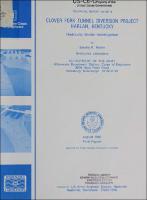Please use this identifier to cite or link to this item:
https://hdl.handle.net/11681/13243| Title: | Clover Fork Tunnel Diversion Project, Harlan, Kentucky : hydraulic model investigation |
| Authors: | United States. Army. Corps of Engineers. Nashville District Martin, Sandra K. |
| Keywords: | Blockage Losses Tunnels Debris Pier design Floating debris STREMR Diversion structures Hydrodynamics Hydraulic models Hydraulic structures Harlan, Kentucky |
| Publisher: | Hydraulics Laboratory (U.S.) Engineer Research and Development Center (U.S.) |
| Series/Report no.: | Technical report (U.S. Army Engineer Waterways Experiment Station) ; HL-89-18. |
| Description: | Technical Report Abstract: A tunnel diversion project has been authorized that will divert the full flow of the Clover Fork near Harlan, KY, to an outlet downstream of the city. The project has a diversion structure at the upstream end of the project that will direct the flow of the Clover Fork into four inverted U-shaped tunnels that average 1,936 ft in length. The narrow floodplain upstream of the project site is filled with debris that could potentially reach the entrance to the tunnels during the Standard Project Flood (SPF). A 1:30-scale physical model was constructed to assess the tunnel entrance for the improvement of hydrodynamic conditions and the mitigation of potential floating debris problems. A two-dimensional depth-averaged numerical hydrodynamic model was used in conjunction with the physical model to screen alternatives that would streamline the approach. The physical model investigated these alternatives for their capability to pass debris by reproducing the SPF hydrograph while simultaneously introducing predicted volume of scaled debris. Features reproduced in the physical model included about 2,000 ft of the natural channel upstream of the tunnel entrance, the diversion structure, the proposed tunnel entrance, and 450 ft of the tunnels. The testing resulted in two entrance designs that not only passed the SPF flow with debris but also provided sufficient freeboard along the diversion structure. |
| Rights: | Approved for public release; distribution is unlimited. |
| URI: | http://hdl.handle.net/11681/13243 |
| Appears in Collections: | Technical Report |
Files in This Item:
| File | Description | Size | Format | |
|---|---|---|---|---|
| TR-HL-89-18.pdf | 2.92 MB | Adobe PDF |  View/Open |